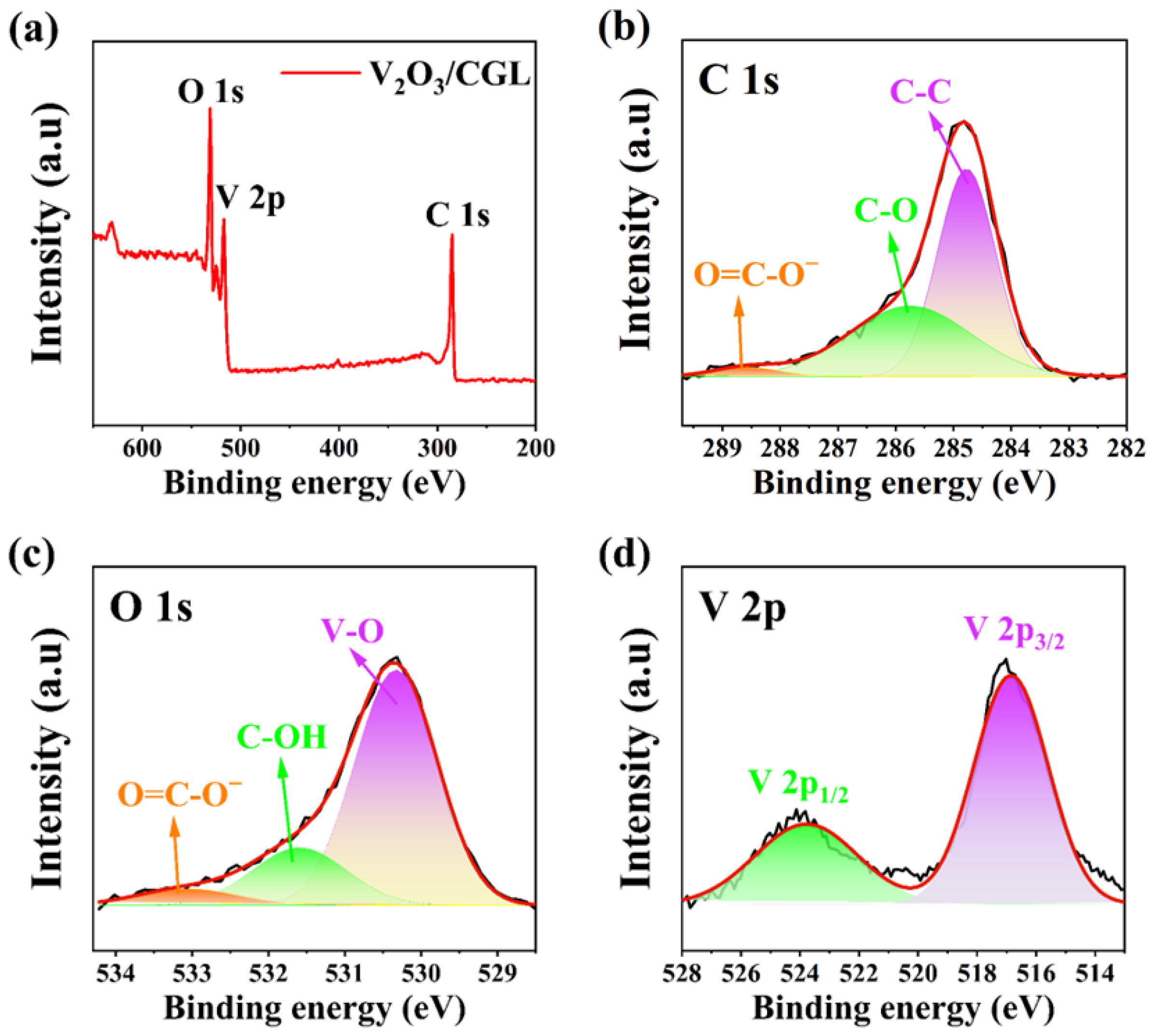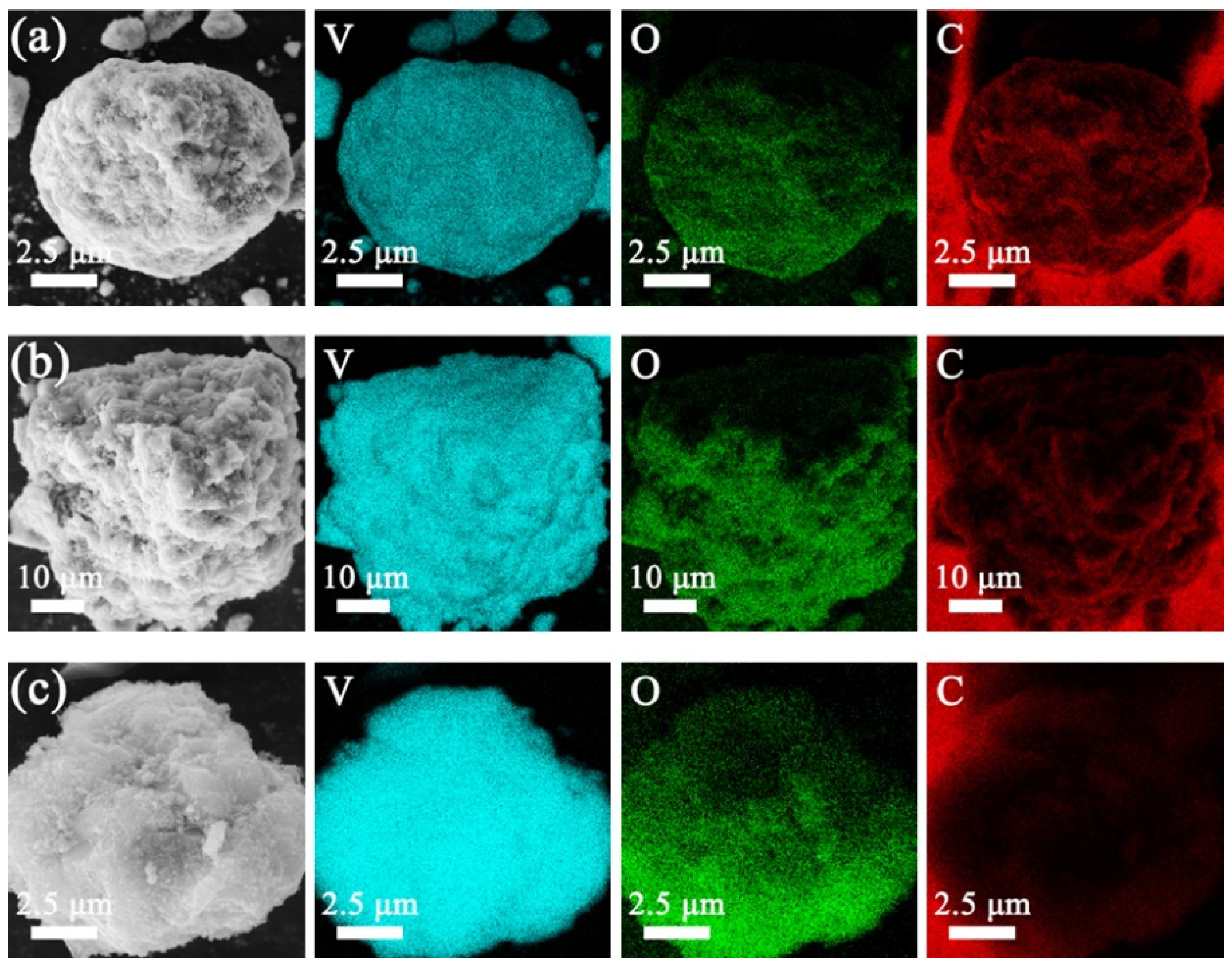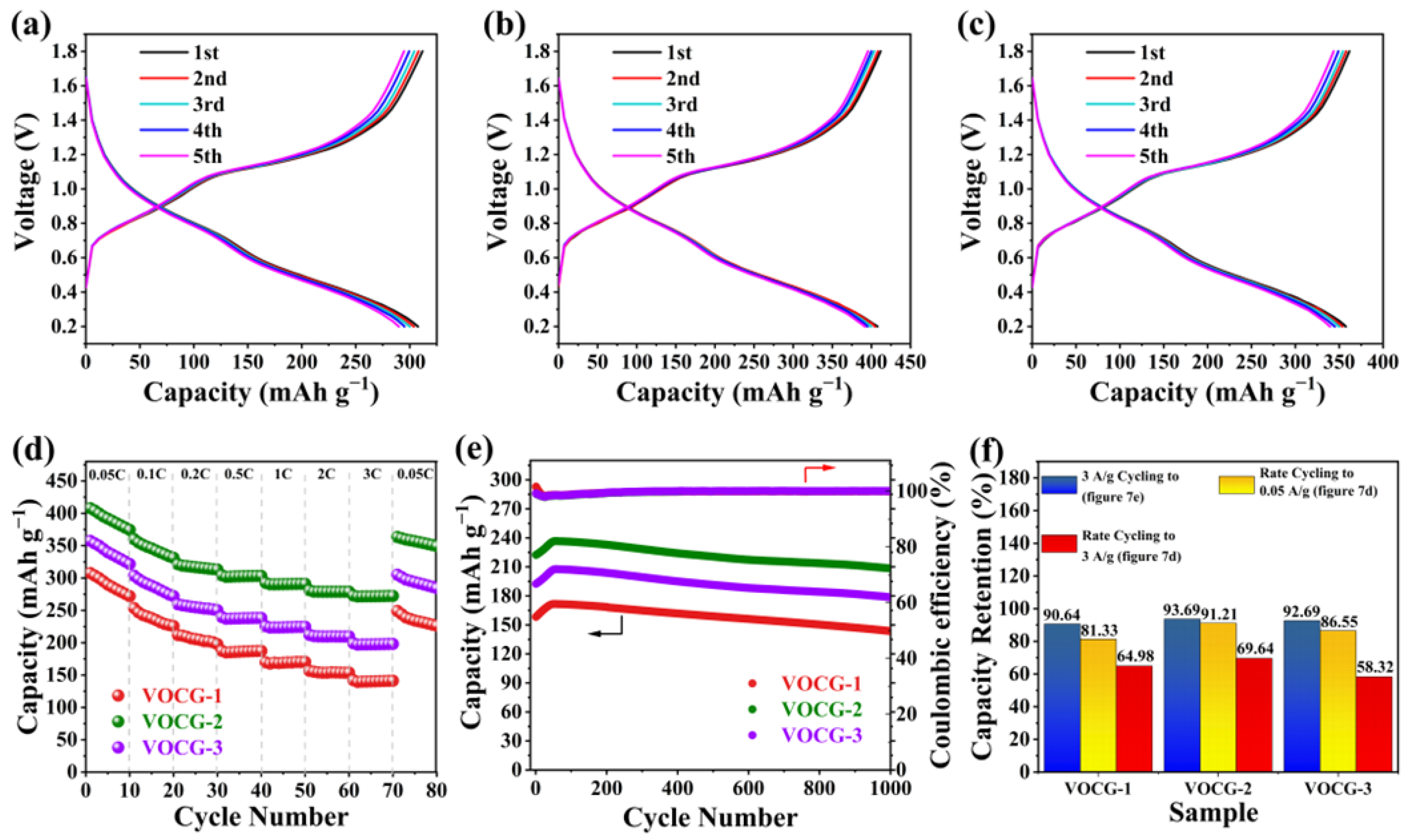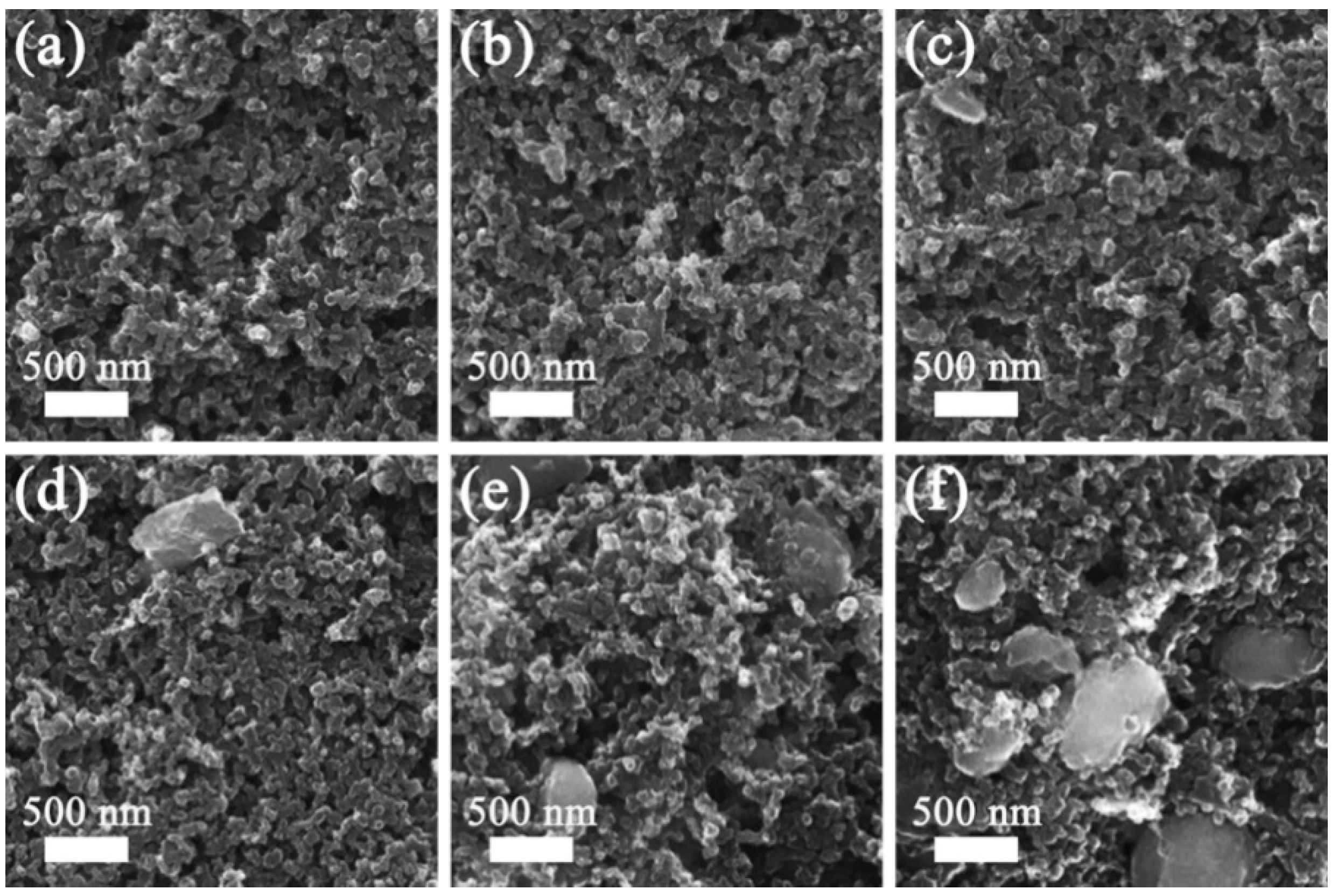Carbonized Ganoderma Lucidum/V2O3 Composites as a Superior Cathode for High-Performance Aqueous Zinc-Ion Batteries
Abstract
1. Introduction
2. Results
3. Discussion
4. Experimental Section
4.1. Preparation of V2O3@CGL Composites
4.2. Material Characterization
4.3. Electrochemical Measurements
5. Conclusions
Author Contributions
Funding
Institutional Review Board Statement
Informed Consent Statement
Data Availability Statement
Conflicts of Interest
References
- Shen, C.; Li, X.; Li, N.; Xie, K.; Wang, J.G.; Liu, X.; Wei, B. Graphene-Boosted, High-Performance Aqueous Zn-Ion Battery. ACS Appl. Mater. Interfaces 2018, 10, 25446–25453. [Google Scholar] [CrossRef] [PubMed]
- Fang, G.; Zhou, J.; Pan, A.; Liang, S. Recent Advances in Aqueous Zinc-Ion Batteries. ACS Energy Lett. 2018, 3, 2480–2501. [Google Scholar] [CrossRef]
- Konarov, A.; Voronina, N.; Jo, J.H.; Bakenov, Z.; Sun, Y.-K.; Myung, S.-T. Present and Future Perspective on Electrode Materials for Rechargeable Zinc-Ion Batteries. ACS Energy Lett. 2018, 3, 2620–2640. [Google Scholar] [CrossRef]
- Ming, F.; Liang, H.; Lei, Y.; Kandambeth, S.; Eddaoudi, M.; Alshareef, H.N. Layered MgxV2O5·nH2O as Cathode Material for High-Performance Aqueous Zinc Ion Batteries. ACS Energy Lett. 2018, 3, 2602–2609. [Google Scholar] [CrossRef]
- Yufit, V.; Tariq, F.; Eastwood, D.S.; Biton, M.; Wu, B.; Lee, P.D.; Brandon, N.P.J.J. Operando visualization and multi-scale tomography studies of dendrite formation and dissolution in zinc batteries. Joule 2019, 3, 485–502. [Google Scholar] [CrossRef]
- Chen, H.; Rong, Y.; Yang, Z.; Deng, L.; Wu, J. V2O3@Amorphous Carbon as a Cathode of Zinc Ion Batteries with High Stability and Long Cycling Life. Ind. Eng. Chem. Res. 2021, 60, 1517–1525. [Google Scholar] [CrossRef]
- Zhang, Y.; Xu, L.; Jiang, H.; Liu, Y.; Meng, C. Polyaniline-expanded the interlayer spacing of hydrated vanadium pentoxide by the interface-intercalation for aqueous rechargeable Zn-ion batteries. J. Colloid Interface Sci. 2021, 603, 641–650. [Google Scholar] [CrossRef] [PubMed]
- Niu, Y.; Wang, D.; Ma, Y.; Zhi, L. Cascading V2O3/N-doped carbon hybrid nanosheets as high-performance cathode materials for aqueous zinc-ion batteries. Chin. Chem. Lett. 2022, 33, 1430–1434. [Google Scholar] [CrossRef]
- Liu, Y.; Wang, T.; Sun, Y.; Zhang, M.; Gao, G.; Yang, J.; Cai, K. Fast and efficient in-situ construction of low crystalline PEDOT-intercalated V2O5 nanosheets for high-performance zinc-ion battery. Chem. Eng. J. 2024, 484, 149501. [Google Scholar] [CrossRef]
- Gao, Q.-L.; Li, D.-S.; Liu, X.-M.; Wang, Y.-F.; Liu, W.-L.; Ren, M.-M.; Kong, F.-G.; Wang, S.-J.; Zhou, R.-C. Biomass-derived mesoporous carbons materials coated by α-Mn3O4 with ultrafast zinc-ion diffusion ability as cathode for aqueous zinc ion batteries. Electrochim. Acta 2020, 335, 135642. [Google Scholar] [CrossRef]
- Tang, B.; Shan, L.; Liang, S.; Zhou, J. Issues and opportunities facing aqueous zinc-ion batteries. Energy Environ. Sci. 2019, 12, 3288–3304. [Google Scholar] [CrossRef]
- Lan, B.; Tang, C.; Chen, L.; Zhang, W.; Tang, W.; Zuo, C.; Fu, X.; Dong, S.; An, Q.; Luo, P. FeVO4⋅nH2O@rGO nanocomposite as high performance cathode materials for aqueous Zn-ion batteries. J. Alloys Compd. 2020, 818, 153372. [Google Scholar] [CrossRef]
- Zhang, W.; Xiao, Y.; Zuo, C.; Tang, W.; Liu, G.; Wang, S.; Cai, W.; Dong, S.; Luo, P. Adjusting the Valence State of Vanadium in VO2(B) by Extracting Oxygen Anions for High-Performance Aqueous Zinc-Ion Batteries. ChemSusChem 2020, 14, 971–978. [Google Scholar] [CrossRef] [PubMed]
- Kidanu, W.G.; Hur, J.; Choi, H.W.; Kim, M.I.; Kim, I.T. High capacity and inexpensive multivalent cathode materials for aqueous rechargeable Zn-ion battery fabricated via in situ electrochemical oxidation of VO2 nanorods. J. Power Sources 2022, 523, 231060. [Google Scholar] [CrossRef]
- Liu, Y.; Hu, P.; Liu, H.; Wu, X.; Zhi, C. Tetragonal VO2 hollow nanospheres as robust cathode material for aqueous zinc ion batteries. Mater. Today Energy 2020, 17, 100431. [Google Scholar] [CrossRef]
- Liu, Y.; Liu, Y.; Wu, X.; Cho, Y.-R. Enhanced Electrochemical Performance of Zn/VOx Batteries by a Carbon-Encapsulation Strategy. ACS Appl. Mater. Interfaces 2022, 14, 11654–11662. [Google Scholar] [CrossRef] [PubMed]
- Lv, T.-T.; Luo, X.; Yuan, G.-Q.; Yang, S.-Y.; Pang, H. Layered VO2@N-doped carbon composites for high-performance rechargeable aqueous zinc-ion batteries. Chem. Eng. J. 2022, 428, 131211. [Google Scholar] [CrossRef]
- Ding, Y.; Peng, Y.; Chen, W.; Niu, Y.; Wu, S.; Zhang, X.; Hu, L. V-MOF derived porous V2O5 nanoplates for high performance aqueous zinc ion battery. Appl. Surf. Sci. 2019, 493, 368–374. [Google Scholar] [CrossRef]
- Hu, P.; Zhu, T.; Wang, X.; Wei, X.; Yan, M.; Li, J.; Luo, W.; Yang, W.; Zhang, W.; Zhou, L.; et al. Highly durable Na2V6O16·1.63H2O nanowire cathode for aqueous zinc-ion battery. Nano Lett. 2018, 18, 1758–1763. [Google Scholar] [CrossRef] [PubMed]
- Hei, J.; Cheng, L.; Fu, Y.; Du, W.; Qian, Y.; Li, J.; Yin, Y.; Wang, N.; Su, L.; Wang, L. Uniformly confined V2O3 quantum dots embedded in biomass derived mesoporous carbon toward fast and stable energy storage. Ceram. Int. 2023, 49, 16002–16010. [Google Scholar] [CrossRef]
- He, Z.; Cheng, G.; Jiang, Y.; Li, Y.; Zhu, J.; Meng, W.; Zhou, H.; Dai, L.; Wang, L. Novel 2D porous carbon nanosheet derived from biomass: Ultrahigh porosity and excellent performances toward V2+/V3+ redox reaction for vanadium redox flow battery. Int. J. Hydrogen Energy 2020, 45, 3959–3970. [Google Scholar] [CrossRef]
- Li, Y.; Lin, W.; Xue, L.; Xie, J.; Wei, B.; Chen, G.; Chen, D. Facile preparation of V2O3/black fungus-derived carbon composite with hierarchical porosity as a promising electrode for lithium/sodium ion batteries. J. Alloys Compd. 2022, 905, 164258. [Google Scholar] [CrossRef]
- Doǧan, H.; Taş, M.; Meşeli, T.; Elden, G.; Genc, G. Review on the Applications of Biomass-Derived Carbon Materials in Vanadium Redox Flow Batteries. ACS Omega 2023, 8, 34310–34327. [Google Scholar] [CrossRef] [PubMed]
- Zhai, M.; Ye, J.; Jiang, Y.; Yuan, S.; Li, Y.; Liu, Y.; Dai, L.; Wang, L.; He, Z. Biomass-derived carbon materials for vanadium redox flow battery: From structure to property. J. Colloid Interface Sci. 2023, 651, 902–918. [Google Scholar] [CrossRef] [PubMed]
- Hu, J.; Xie, Y.; Zheng, J.; Li, H.; Wang, T.; Lai, Y.; Zhang, Z. Encapsulating V2O3 Nanoparticles in Hierarchical Porous Carbon Nanosheets via C–O–V Bonds for Fast and Durable Potassium-Ion Storage. ACS Appl. Mater. Interfaces 2021, 13, 12149–12158. [Google Scholar] [CrossRef] [PubMed]
- Henry, A.; Hesemann, P.; Alauzun, J.G.; Boury, B. Reductive mineralization of cellulose with vanadium, iron and tungsten chlorides and access to MxOy metal oxides and MxOy/C metal oxide/carbon composites. Carbohydr. Polym. 2017, 174, 697–705. [Google Scholar] [CrossRef] [PubMed]
- Zheng, J.; Zhang, Y.; Jing, X.; Liu, X.; Hu, T.; Lv, T.; Zhang, S.; Meng, C. Synthesis of amorphous carbon coated on V2O3 core-shell composites for enhancing the electrochemical properties of V2O3 as supercapacitor electrode. Colloids Surf. A Physicochem. Eng. Asp. 2017, 518, 188–196. [Google Scholar] [CrossRef]
- Feng, Z.; Zhang, Y.; Yu, X.; Yu, Y.; Huang, C.; Meng, C. Aluminum-ion intercalation and reduced graphene oxide wrapping enable the electrochemical properties of hydrated V2O5 for Zn-ion storage. Colloids Surf. A Physicochem. Eng. Asp. 2022, 641, 128473. [Google Scholar] [CrossRef]
- Liu, Y.; Pan, Z.; Tian, D.; Hu, T.; Jiang, H.; Yang, J.; Sun, J.; Zheng, J.; Meng, C.; Zhang, Y. Employing “one for two” strategy to design polyaniline-intercalated hydrated vanadium oxide with expanded interlayer spacing for high-performance aqueous zinc-ion batteries. Chem. Eng. J. 2020, 399, 125842. [Google Scholar] [CrossRef]
- Ouyang, D.; Wang, C.; Yang, L.; Zhang, Y.; Wang, Y.-N.; Zhu, H.; Yu, F.; Yin, J. Enhancing Potassium Storage Performance in VO2/V2O3@C Nanosheets by Synergistic Effect of Oxygen Vacancy and C-O-V Bond. ChemElectroChem 2022, 9, e202200639. [Google Scholar] [CrossRef]
- Hu, T.; Liu, Y.; Zhang, Y.; Nie, Y.; Zheng, J.; Wang, Q.; Jiang, H.; Meng, C. Encapsulating V2O3 nanorods into carbon core-shell composites with porous structures and large specific surface area for high performance solid-state supercapacitors. Microporous Mesoporous Mater. 2018, 262, 199–206. [Google Scholar] [CrossRef]
- Gou, W.; Kong, X.; Wang, Y.; Ai, Y.; Liang, S.; Pan, A.; Cao, G. Yolk-shell structured V2O3 microspheres wrapped in N, S co-doped carbon as pea-pod nanofibers for high-capacity lithium ion batteries. Chem. Eng. J. 2019, 374, 545–553. [Google Scholar] [CrossRef]
- Kim, J.-H.; Kim, Y.-S.; Moon, S.-H.; Park, D.-H.; Kim, M.-C.; Choi, J.-H.; Shin, J.-H.; Park, K.-W. Enhanced electrochemical performance of a selectively formed V2O3/C composite structure for Li-ion batteries. Electrochim. Acta 2021, 389, 138685. [Google Scholar] [CrossRef]
- Deng, L.; Chen, H.; Wu, J.; Yang, Z.; Rong, Y.; Fu, Z. V2O3 as cathode of zinc ion battery with high stability and long cycling life. Ionics 2021, 27, 3393–3402. [Google Scholar] [CrossRef]
- Liu, X.; Wang, Z.; Niu, Y.; Liu, C.; Chen, H.; Ren, X.; Wang, M.; Lau, W.-M.; Zhou, D. Scalable synthesis of novel V2O3/carbon composite as advanced cathode material for aqueous zinc-ion batteries. Ceram. Int. 2022, 48, 15594–15602. [Google Scholar] [CrossRef]
- Liu, C.L.; Liu, Y.; Liu, X.; Gong, Y. Coordination polymer-derived Al3+-doped V2O3/C with rich oxygen vacancies for an advanced aqueous zinc-ion battery with ultrahigh rate capability. Sustain. Energy Fuels 2022, 6, 2020–2037. [Google Scholar] [CrossRef]
- Wang, J.; Li, G.; Liu, X.; Ouyang, Q.; Ma, M.; Wang, Q.; Zhang, X.; Fan, Z.; Li, L. In-situ electrochemical oxidization of V2O3-C cathode for boosted zinc-ion storage performance. Appl. Surf. Sci. 2023, 616, 156481. [Google Scholar] [CrossRef]
- Wang, Q.; Feng, Q.; Lei, Y.; Tang, S.; Xu, L.; Xiong, Y.; Fang, G.; Wang, Y.; Yang, P.; Liu, J.; et al. Quasi-solid-state Zn-air batteries with an atomically dispersed cobalt electrocatalyst and organohydrogel electrolyte. Nat. Commun. 2022, 13, 3689. [Google Scholar] [CrossRef] [PubMed]
- Liu, X.; Wang, Z.; Niu, Y.; Liu, C.; Chen, H.; Ren, X.; Liu, Z.; Lau, W.-M.; Zhou, D. Electrospun V2O3@Carbon Nanofibers as a Flexible and Binder-Free Cathode for Highly Stable Aqueous Zn-Ion Full Batteries. ACS Appl. Energy Mater. 2022, 5, 3525–3535. [Google Scholar] [CrossRef]
- Zhang, H.; Zhang, Y.; Liu, Y.; Shi, X.; Zhang, Y.; Bai, L.; Wang, Q.; Sun, L. Oxygen-Deficient α-MnO2 Nanotube/Graphene/N, P Codoped Porous Carbon Composite Cathode To Achieve High-Performing Zinc-Ion Batteries. ACS Appl. Mater. Interfaces 2022, 14, 36668–36678. [Google Scholar] [CrossRef] [PubMed]
- Zhao, J.; Zhao, Y.; Yue, W.-C.; Li, X.; Gao, N.; Zhang, Y.-J.; Hu, C.-Q. V2O3/VN Catalysts Decorated Free-Standing Multifunctional Interlayer for High-Performance Li-S Battery. Chem. Eng. J. 2022, 441, 136082. [Google Scholar] [CrossRef]
- Chen, H.; Wang, Y.; Liu, C.; Hou, L.; Sun, J.; Yuan, C. Two-dimensional V2CTx In-situ Derived Porous V2O3@C Flakes Towards Zinc-Ion Capacitors as a Competitive Cathode Material. ChemNanoMat 2022, 9, e202200394. [Google Scholar] [CrossRef]
- Zhang, H.; Yao, Z.; Lan, D.; Liu, Y.; Ma, L.; Cui, J. N-doped carbon/V2O3 microfibers as high-rate and ultralong-life cathode for rechargeable aqueous zinc-ion batteries. J. Alloys Compd. 2021, 861, 158560. [Google Scholar] [CrossRef]
- Shin, J.; Jung, H.; Kim, Y.; Kim, J. Carbon-coated V2O5 nanoparticles with enhanced electrochemical performance as a cathode material for lithium ion batteries. J. Alloys Compd. 2014, 589, 322–329. [Google Scholar] [CrossRef]
- Duan, Y.; Geng, Z.; Zhang, D.; Wang, Q. In situ electrochemically activated V2O3@MXene cathode for a super high-rate and long-life Zn-ion battery. Dalton Trans. 2024, 53, 7023–7034. [Google Scholar] [CrossRef] [PubMed]
- Yin, C.; Wang, H.; Pan, C.; Li, Z.; Hu, J. Constructing MOF-derived V2O5 as advanced cathodes for aqueous zinc ion batteries. J. Energy Storage 2023, 73, 109045. [Google Scholar] [CrossRef]
- Zhou, W.; Zeng, G.; Jin, H.; Jiang, S.; Huang, M.; Zhang, C.; Chen, H. Bio-Template Synthesis of V2O3@Carbonized Dictyophora Composites for Advanced Aqueous Zinc-Ion Batteries. Molecules 2023, 28, 2147. [Google Scholar] [CrossRef] [PubMed]
- Zeng, G.; Wang, Y.; Lou, X.; Chen, H.; Jiang, S.; Zhou, W. Vanadium oxide/carbonized chestnut needle composites as cathode materials for advanced aqueous zinc-ion batteries. J. Energy Storage 2024, 77, 109859. [Google Scholar] [CrossRef]
- Wu, T.-H.; Li, Y.-M.; Ni, K.-Y.; Li, T.-K.; Lin, W.-S. Vanadium oxides obtained by chimie douce reactions: The influences of transition metal species on crystal structures and electrochemical behaviors in zinc–ion batteries. J. Colloid Interface Sci. 2022, 608, 3121–3129. [Google Scholar] [CrossRef] [PubMed]
- Xu, L.; Zhang, Y.; Zheng, J.; Jiang, H.; Hu, T.; Meng, C. Ammonium ion intercalated hydrated vanadium pentoxide for advanced aqueous rechargeable Zn-ion batteries. Mater. Today Energy 2020, 18, 100509. [Google Scholar] [CrossRef]
- Venkatkarthick, R.; Rodthongkum, N.; Zhang, X.; Wang, S.; Pattananuwat, P.; Zhao, Y.; Liu, R.; Qin, J. Vanadium-Based Oxide on Two-Dimensional Vanadium Carbide MXene (V2Ox@V2CTx) as Cathode for Rechargeable Aqueous Zinc-Ion Batteries. ACS Appl. Energy Mater. 2020, 3, 4677–4689. [Google Scholar] [CrossRef]
- Hu, J.; Chen, H.; Xiang, K.; Xiao, L.; Chen, W.; Liao, H.; Chen, H. Preparation for V6O13@hollow carbon microspheres and their remarkable electrochemical performance for aqueous zinc-ion batteries. J. Alloys Compd. 2021, 856, 157085. [Google Scholar] [CrossRef]
- Bin, D.; Wang, Y.; Tamirat, A.G.; Zhu, P.; Yang, B.; Wang, J.; Huang, J.; Xia, Y. Stable High-Voltage Aqueous Zinc Battery Based on Carbon-Coated NaVPO4F Cathode. ACS Sustain. Chem. Eng. 2021, 9, 3223–3231. [Google Scholar] [CrossRef]
- Hong, J.; Xie, L.; Shi, C.; Lu, X.; Shi, X.; Cai, J.; Wu, Y.; Shao, L.; Sun, Z. High-Performance Aqueous Zinc-Ion Batteries Based on Multidimensional V2O3 Nanosheets@Single-Walled Carbon Nanohorns@Reduced Graphene Oxide Composite and Optimized Electrolyte. Small Methods 2024, 8, 2300205. [Google Scholar] [CrossRef] [PubMed]
- Pan, D.; Liu, T.; Fu, J.; Liu, H. Superior electrochemical performance of dual-monoclinic δ-NaxV2O5/VO2(B) composite material with enhanced synergistic effects. J. Alloys Compd. 2022, 926, 166952. [Google Scholar] [CrossRef]










| Sample | Pore Volume (cm3 g−1) | Specific Surface Area (m2 g−1) | Average Pore Size (Å) |
|---|---|---|---|
| VOCG-1 | 0.1424 | 154.9935 | 3.6760 |
| VOCG-2 | 0.1647 | 164.5602 | 4.0040 |
| VOCG-3 | 0.1589 | 174.2683 | 3.6465 |
| Sample | VOCG-1 | VOCG-2 | VOCG-3 |
|---|---|---|---|
| Rct (before cycling) | 180.8 Ω | 129.8 Ω | 141 Ω |
| Rct (after cycling) | 63.47 Ω | 40.92 Ω | 55.29 Ω |
| Rs (before cycling) | 4.04 Ω | 2.56 Ω | 3.73 Ω |
| Rs (after cycling) | 7.72 Ω | 3.72 Ω | 4.48 Ω |
| Sample | Cycle Number | Capacity Retention | Current Density (A g−1) | Specific Capacity (mAh g−1) | Ref. |
|---|---|---|---|---|---|
| VOCG-2 | 1000 | 93.69% | 3 | 208.38 | This work |
| V2O3@carbonized Dictyophora | 1000 | 89.24% | 1 | 151.9 | [47] |
| V2O3/carbonized chestnut needle | 1000 | 94.26% | 3 | 213.66 | [48] |
| V2O3 | 100 | 76.9% | 0.1 | 161 | [34] |
| Polyaniline-intercalated V2O5@nH2O | 100 | 57% | 0.1 | 196 | [7] |
| Mn0.31V3O7@1.40H2O | 500 | 54% | 1 | 164 | [49] |
| (NH4)xV2O5@nH2O | 50 | 63% | 0.1 | 235 | [50] |
| V2Ox@V2CTx | 200 | 81.6% | 1 | 87.3 | [51] |
| V2O3@carbon nanofibers | 1000 | 80% | 0.2 | 120 | [39] |
| V6O13@hollow carbon microspheres | 1000 | 76% | 1 | 162.1 | [52] |
| Carbon-coated NaVPO4F | 400 | 94.5% | 0.1 | 87.4 | [53] |
| V2O3@amorphous carbon | 1600 | 90.7% | 1 | 116 | [6] |
| V2O3@rGO | 1000 | 114% | 5 | 195 | [54] |
| VO2 hollow nanospheres | 860 | 47.6% | 1 | 143 | [15] |
| δ-NaxV2O5/VO2(B) | 200 | 94% | 4 | 253 | [55] |
| FeVO4·nH2O@rGO | 1000 | 43.8% | 1 | 92 | [12] |
| Sample | CGL | NH4VO3 | CH4NO2 | C2H6O2 | H2O |
|---|---|---|---|---|---|
| VOCG-1 | 0.3 g | 5.04 g | 3.43 g | 40 mL | 100 mL |
| VOCG-2 | 0.3 g | 6.24 g | 4.26 g | 40 mL | 100 mL |
| VOCG-3 | 0.3 g | 7.40 g | 5.05 g | 40 mL | 100 mL |
Disclaimer/Publisher’s Note: The statements, opinions and data contained in all publications are solely those of the individual author(s) and contributor(s) and not of MDPI and/or the editor(s). MDPI and/or the editor(s) disclaim responsibility for any injury to people or property resulting from any ideas, methods, instructions or products referred to in the content. |
© 2024 by the authors. Licensee MDPI, Basel, Switzerland. This article is an open access article distributed under the terms and conditions of the Creative Commons Attribution (CC BY) license (https://creativecommons.org/licenses/by/4.0/).
Share and Cite
Zeng, G.; Li, Z.; Jiang, S.; Zhou, W. Carbonized Ganoderma Lucidum/V2O3 Composites as a Superior Cathode for High-Performance Aqueous Zinc-Ion Batteries. Molecules 2024, 29, 3688. https://doi.org/10.3390/molecules29153688
Zeng G, Li Z, Jiang S, Zhou W. Carbonized Ganoderma Lucidum/V2O3 Composites as a Superior Cathode for High-Performance Aqueous Zinc-Ion Batteries. Molecules. 2024; 29(15):3688. https://doi.org/10.3390/molecules29153688
Chicago/Turabian StyleZeng, Guilin, Zhengda Li, Shaohua Jiang, and Wei Zhou. 2024. "Carbonized Ganoderma Lucidum/V2O3 Composites as a Superior Cathode for High-Performance Aqueous Zinc-Ion Batteries" Molecules 29, no. 15: 3688. https://doi.org/10.3390/molecules29153688
APA StyleZeng, G., Li, Z., Jiang, S., & Zhou, W. (2024). Carbonized Ganoderma Lucidum/V2O3 Composites as a Superior Cathode for High-Performance Aqueous Zinc-Ion Batteries. Molecules, 29(15), 3688. https://doi.org/10.3390/molecules29153688








